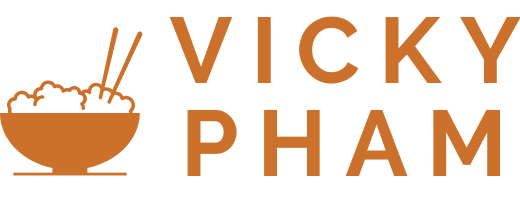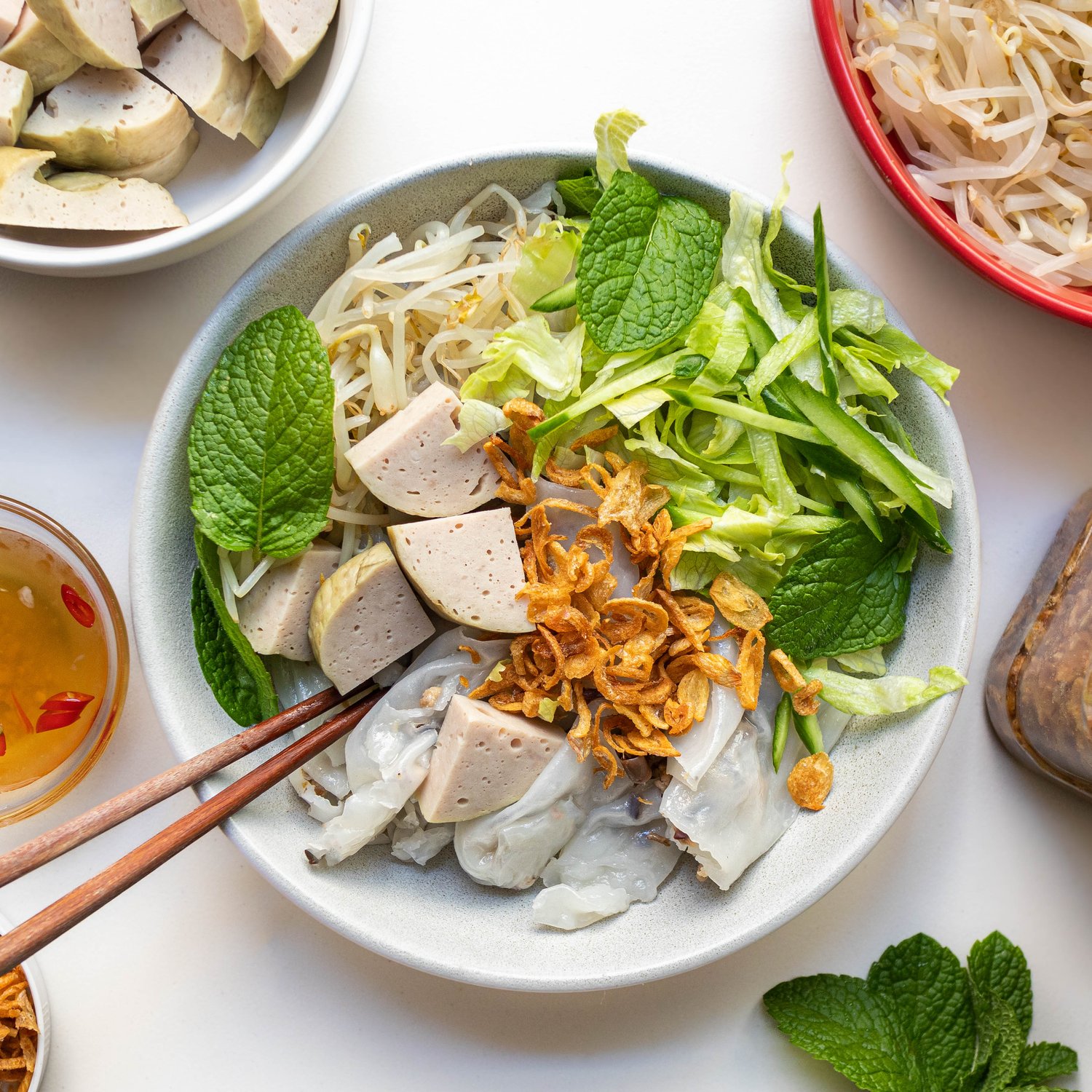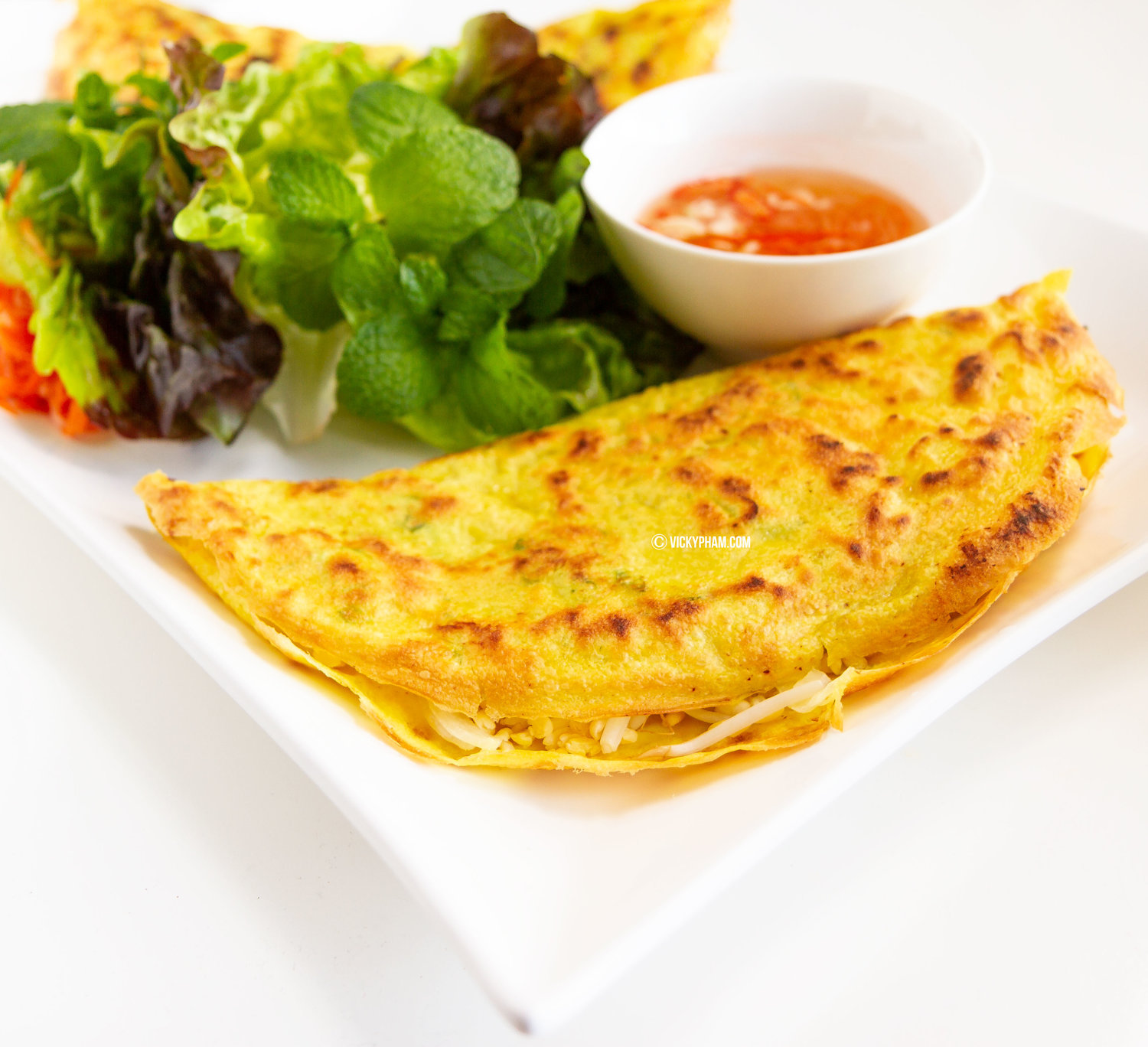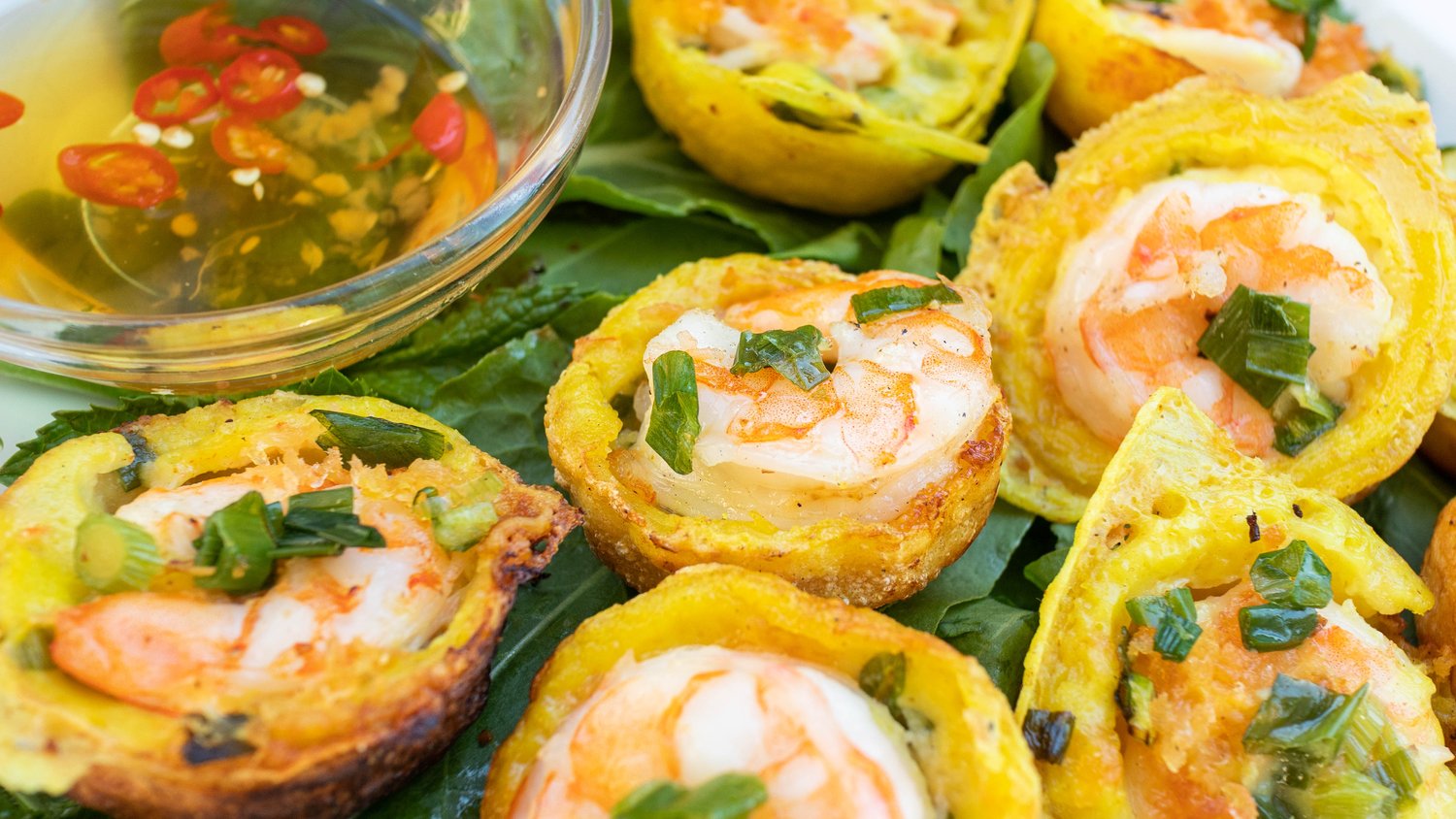Vietnamese Steamed Rice Noodle Sheets/Rolls (Bánh Ướt)
This post contains affiliate links which we are compensated for if a purchase is made. Using links costs you nothing and helps to support the ongoing creation of content. • Jump to Recipe
What is Bánh Ướt?
Bánh Ướt are Vietnamese steamed rice sheets or rolls that come without fillings. They are a popular street food that can be enjoyed for either breakfast, lunch, or dinner.
These thin, delicate rice sheets/rolls are served with a variety of toppings such as cucumbers, Vietnamese ham (Chả Lụa), beansprouts and a flavorful dipping sauce, known as Nước Chấm.
Banh Uot directly translates to "wet cakes." The name refers to the traditional cooking method when the wet rice batter is poured onto a damp cloth for steaming.
Vietnamese Steamed Rice Noodles Sheet/Rolls (Bánh Ướt)
What is the Difference between Bánh Ướt and Bánh Cuốn?
Banh Uot and Banh Cuon are two similar Vietnamese dishes that are often mistaken for each other because they are made with the same rice batter. The only difference is how they are prepared.
Banh Uot can be served in sheets or rolled up, but most importantly, it has no filling. Banh Cuon, on the other hand, is rolled up with a filling of ground pork, onions, and wood ear mushrooms.
Bánh Ướt Batter
Banh Uot is made from a thin batter of rice flour, tapioca starch, and water. Rice flour is the main ingredient, and tapioca starch is added to make the rice sheet elastic and chewy.
Rice flour and tapioca flour — the two starches to make Banh Uot batter
Potato starch can be used to substitute for some of the tapioca starch. I’m not a fan of too much tapioca starch so I like to replace some tapioca starch with potato starch. Potato starch helps with the elasticity but it has more of a neutral flavor than tapioca starch.
Banh Uot batter
Different Cooking Methods for Bánh Ướt
Traditional Steaming
Banh Uot batter can be steamed on a specialized steamer with a cloth stretched over a large pot of boiling water.
This is the traditional method used by street food vendors in Vietnam, but it is not the most practical for home cooks.
Frying Pan for “Steaming”
Another option is to “steam” Banh Uot in a frying pan with a lid. I have demonstrated this method in my recipe for Bánh Cuốn with step-by-step pictures. You can follow along here.
This is a quick and easy alternative, but it doesn't have the same smooth texture as steaming.
Steaming Hack for Home Cooking
In this recipe, I’ll focus on actually steaming Banh Uot with equipment that most people probably already have at home.
If you don’t have a cloth and steaming contraption that vendors in Vietnam use, you can still steam Banh Uot using a large skillet with a lid and two nonstick shallow baking/cake pans.
Make sure the baking pans will fit inside the skillet when covered. It’s also helpful to have multiple baking pans so that you can avoid waiting too long between making the rice sheets.
Banh Uot ready for serving
How to Make it
Step 1 – Make the Batter
Combine rice flour, tapioca starch, potato starch, salt and water. Mix together until flour and starches have completely dissolved. Let it sit for 30 minutes to bloom.
If you don’t the individual ingredients to make the batter from scratch, you can purchase the flour premix on Amazon.
Step 2 – Prepare Your Station
Set up your steamer by filling a large pot/skillet or a large steamer with about 2 inches of water.
If using a large pot/skillet, place a shallow bowl or large plate at the bottom of the pot to keep the baking sheet from sitting directly in the water.
Prepare a large plate or tray by greasing with shallot oil. Set aside. This will be used to place the finished rice rolls.
Step 3 — Steaming
Pour about ⅓ cup of batter onto the baking pan and swirl it to form a thin even layer.
Cover the pot with a lid and steam for about 2 minutes, or until the batter is translucent and cooked through.
Carefully remove the baking pan with tongs or mittens. It should look like the below picture.
Use a wooden chopstick to trace the outline of the rice sheet along the edges to loosen them.
It’s important to use a wooden chopstick to prevent sticking. Other materials such as metal or stainless steel don’t work so well.
Use the chopstick to nudge one side of the rice sheet so you can lift it off.
I find it easier if you roll it up completely rather than trying to lift the whole sheet. If it's too fragile and breaks apart easily, allow the rice sheet to cool for about 30 seconds to 1 minute.
Transfer the Banh Uot to an oiled tray and brush with more shallot oil to prevent sticking.
Repeat the above steps until batter runs out. Once you get the hang of it, you can get multiple trays going at once.
Banh Uot does require some practice, but it is not difficult to learn. Don't be discouraged if your first attempt doesn't turn out perfectly, because that's perfectly normal!
Like making Vietnamese sizzling crepes (Banh Xeo), the first one is always the sacrifice. Just keep trying and you'll soon get the hang of it.
Here are some store-bought Banh Uot I got.
They came in sheets.
What is Served with Bánh Ướt?
Banh Uot is typically served on a plate with a variety of toppings. These toppings include:
Blanched bean sprouts
Bean sprouts
Blanched bean sprouts
Thinly sliced cucumbers — I like use Persian or English cucumbers.
Persian cucumbers, sliced and julienned
Vietnamese ham (chả lụa) — Cut into thick circular slices, wedges, or matchsticks
Vietnamese ham (chả lụa)
Vietnamese ham cut into thick circular slices, wedges, or matchsticks
Chopped lettuce
Vietnamese herbs such as Thai basil, mint, and Vietnamese coriander (rau răm)
Banh Uot also comes with a bowl of sauce called nước chấm. This is Vietnam’s mother sauce and it’s made with primarily fish sauce, lime juice, sugar, garlic, and chili peppers
How to Eat Bánh Ướt
To eat Banh Uot, drizzle the sauce over the noodles and all its topping. Give it a mix and enjoy the contrasting textures and flavors of the dish.
Alternatively, you can dip the Banh Uot in the sauce rather than pouring the sauce over the rice sheets.
Tips for a Successful Bánh Ướt
Whisk the batter until it is completely smooth before pouring. Rice flour and starches tend to settle at the bottom quickly. You want to evenly mix it up before every pour.
If you don't have all flour and starches on hand, you can use a pre-mixed Banh Cuon flour. A really good brand is Vinh Thuan. This will save some time. The package will say Banh Cuon but it’s the same flour mixture for Banh Uot.
Use shallot oil instead of regular oil. If you make your own crispy fried shallots, simply strain the oil to remove any fried bits and you will have shallot oil. Brush it onto the steamed rice sheets/rolls to provide an amazing aroma and to prevent them from sticking to each other. Game changer!
It's crucial to clear a large counter space before steaming. Cooking Banh Uot involves an assembly line of little steps, and having everything ready and plenty of room will make things easier.
Vietnamese Steamed Rice Noodles Sheet/Rolls (Bánh Ướt)

Vietnamese Steamed Rice Noodle Sheets/Rolls (Bánh Ướt)
Ingredients
Instructions
- Make the batter. Combine rice flour, tapioca starch, potato starch, salt and water. Mix together until flour and starches have completely dissolved. Let it sit for 30 minutes to bloom.
- Prepare a tray by greasing with shallot oil. Set aside. This will be used to place the finished rice rolls.
- Fill a large pot/skillet or a large steamer with about 2 inches of water. If using a large pot/skillet, place a shallow bowl or plate at the bottom of the pot to keep the baking pan from sitting directly in the water. Place the baking pan inside. I'm using a 9-inch round nonstick cake pan. Bring the water to a boil over medium-high heat.
- Pour about ⅓ cup of batter onto the baking pan and swirl it to form a thin even layer. Cover the pot with a lid and steam for about 2 minutes, or until the batter is translucent and cooked through.
- Carefully remove the baking pan with tongs or mittens. Use a wooden chopstick to trace the outline of the rice sheet along the edges to loosen them. The wooden chopstick prevents sticking. Use the chopstick to nudge one side of the rice sheet so you can lift it off. I find it too be much easier if you roll it off rather than trying to lift the whole sheet. If you find it too fragile, allow the rice sheet to cool for about 30 seconds to 1 minute.
- Transfer the Banh Uot to the oiled tray and brush the sheet or rolls with more shallot oil to prevent sticking.
- Repeat the above steps until batter runs out. Once you get the hang of it, you can get multiple trays going at once.
- Assemble 4-5 rolls or sheets per person. Top with desired vegetables and serve with a small bowl of sauce on the side for pouring or dipping and enjoy.
Notes
If you don’t the individual ingredients to make the batter from scratch, you can purchase the flour on Amazon.























